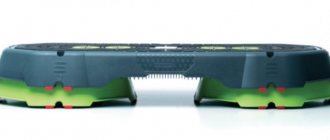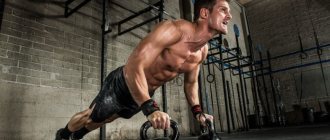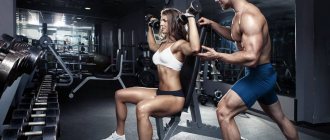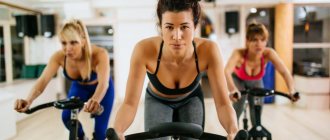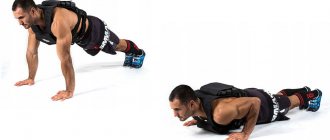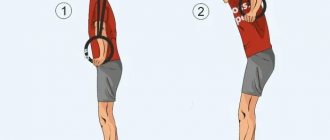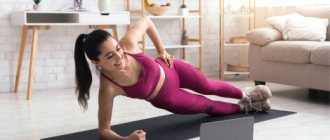Do you think that lifting weights in the gym and doing barbell presses is only for 20-year-old men? Not at all, if you want to maintain a beautiful body and excellent health until old age.
Strength training is exercise that is performed under load. They are aimed at increasing the volume of muscle tissue, increasing strength and endurance. Interestingly, these effects are accompanied by others that are quickly noticed by men and women who go to the gym. Along with the growth of muscle volume, amazing changes occur in the body. Here are the seven main ones.
New body proportions
Strength exercises change the body (Photo: pixabay.com)
If you are planning to “swing” to lose weight, you may be disappointed at the first stage. The fact is that strength training often has the opposite effect, which you will notice on the scale. Your stable, usual weight may suddenly become larger, and only over time it will begin to decrease. Why is this happening?
The fact is that strength training is aimed at increasing the volume of muscle mass, and it naturally has its own weight. Moreover, muscle weighs more than fat, so when your body begins to change, the scale will show completely different numbers than you expect. But soon you will notice that your hips have become steeper and firmer, your arms have become thicker, your chest has become higher, and your waist circumference has decreased.
This is how the redistribution of volumes occurs, which spurs strength training. When there is more muscle in the body, the amount of fat naturally decreases.
How to train for beginners?
“In weight training, you can use exercise machines - pulleys and levers, perform exercises with free weights - barbells and dumbbells, as well as with small equipment (TRX). To determine the load that is appropriate for you, it is best to contact a trainer who can help you test your functional motor abilities. He will assess joint mobility, level of flexibility and coordination and create a training program.
At the initial stage, the load should correspond to 5-7 points on the Borg scale; the challenge will be to acquire and improve basic motor skills. It is best to start with full-body training, which includes basic exercises (squats, bends, presses, rows) and work on simple machines (machine presses, vertical block rows, hyperextension, and so on).
Then the intensity of the training can be gradually increased based on feedback from the trainee.”
Fast Metabolism
Exercise speeds up your metabolism (Photo: pixabay.com)
A fast metabolism is what prevents you from gaining weight, even when you don’t follow any diet. And the body intensively expends energy during sleep or when you brush your teeth. Fast metabolism is characteristic of people engaged in strength training. And it remains consistently high with regular, but not even daily, loads.
It is enough to train three times a week so that the metabolic rate in your body always remains high.
How to avoid traumatic situations?
“There will be a risk of harming yourself if you do not follow the correct technique for doing the exercises. True, this may not be enough, so it is better to perform them under the supervision of trainers who know human anatomy and biomechanics; they also know that the same tasks can be performed differently by different people depending on their anatomical features. With proper training, the musculoskeletal system becomes more stable, and this will be the best prevention of injury.
The main recommendation is to choose the right weight so that the load does not exceed 8 points on the Borg scale, so that it remains possible to control movements both in the negative (for example, when we squat) and in the positive (when we rise) phase. You need to try not to go beyond the anatomical norms, beyond the permissible limits of movement in the joints during exercises, and maintain an average pace.
With an excessive amount of load and an incorrectly designed training program, a fatigue injury can occur - under such conditions, the tissues do not have time to recover. Other “side effects” may include a lack of appetite or an excessive increase in appetite, drowsiness, or insomnia.”
No back pain
The back muscles become stronger (Photo: pixabay.com)
Sedentary work brings back discomfort even to those who have never had problems with the spine. Strength training strengthens the muscular corset and maintains the spine in a physiological position. This prevents the development of osteochondrosis - the main “scourge” of office workers. It also helps to avoid back pain if you have scoliosis.
Enough strength for everything
Walk with your child, clean the apartment, iron the laundry, run to the store or spend the whole day in the office and not get tired at all. This is the result of increased endurance of the body, when everyday activities and periodic loads no longer seem difficult. And you also have enough strength to pay attention to your significant other in the evening.
In addition to external manifestations of endurance, there are also internal ones. Strength training increases cardiac endurance. By intensively pumping blood during exercise, the heart muscle becomes stronger and stronger, which protects it from disease.
Working with weights
In this article, intended for beginners, we would like to talk about one of the methods of physical training, which, in our opinion, should be an integral part of any training. In principle, it is already used in many places to one degree or another, but this material can help you look at this approach more consciously - and, thereby, improve your training.
The method itself is extremely simple (and therefore effective) - it is performing technical elements with weights. After all, the greatest strength in movement is achieved precisely in the position in which you trained it. There are basic, general developmental methods such as deadlifts or kettlebell pushes, but now we will talk about a narrower, more specific approach. It was used when training legionnaires in Ancient Rome (and probably even earlier) - the training swords of teenagers were twice as heavy as combat swords. After years of working with such a sword, wielding a combat weapon must have been much easier. In principle, everyone, even those who have never done anything, has experienced something similar at least once - when you put on spring shoes after heavy winter shoes, you immediately feel that walking has become easier.
It is also known that the famous French knight Boucicault used a similar method in the 15th century. His approach was extremely simple - he performed various “applied” movements while wearing armor - not tournament armor, but combat armor, which actually gives quite a lot of (sufficient) freedom of movement. (It couldn’t be otherwise, and it’s unreasonable to consider our ancestors more stupid than ourselves - they did what was necessary for survival in their time and their area - that’s what we should proceed from.)
So: Boucicault, in combat gear weighing about 25-30 kg, climbed the fortress wall a la a climber, climbed the rungs of the ladder on his hands, spent hours chopping wood, practicing with a hammer, jumping on a horse, and just jumping; ran and walked distances (to train the cardiovascular system and endurance). As a result, it was very difficult for him to find opponents.
Of course, this is not exactly the method that we are describing - according to the “ancient Roman” method, Boucicault would have used armor twice as heavy as the real ones, and then, after such training, ordinary armor would have been no heavier for him than clothing, and he could probably do a somersault in it. But we again proceed from the principle of sufficiency - if even with this approach he was practically invincible, why did he need to try harder?
Nowadays, this method is used everywhere - including in athletics, in particular in running. For example, running with a belt that contains sand in its pockets. Naturally, running without a belt is easier and faster. In martial arts, various weights are widely used - vests, weights for arms and legs with adjustable weights, which are usually Velcro strips, and so on.
Another subtype of such work is work with rubber bands, which is also used in martial arts (in particular, wrestling). Typically, rubber imitates the resistance or mass of an opponent, but tensile force can also be used to enhance your actions - even in rugby. For example, you need to be able to run quickly sideways to get past your opponents on the field. By practicing with rubber (as in the video), you can achieve amazing speed in this movement.
Accordingly, you can work with any movement that you need for life or sport. It is necessary to analyze the desired movement (technical element), sort it into parts, and arrange exercises with weights (or efforts).
Let's move on to movements that simulate strikes with a weapon. This is often used in good old boxing - punching the air with dumbbells or pieces of reinforcement in your hands. But here we will still talk about shells that imitate weapons, about more applied techniques. Although, as you know, many unarmed techniques represent the same movement as with a weapon, along the same trajectory, but the blow is delivered by any part of the hand. For example, a blow from top to bottom with the edge of a fist on the bridge of the nose or collarbone - originally it was a blow with a hammer, an ax or a mace. The same aikido is in many ways kendo, but without a sword in the hand. Consequently, by developing movements with a weapon (or its mass-dimensional imitation), we kill two birds with one stone - we train both technical elements with weapons and applied/sports techniques for self-defense/fights. And not only what will be discussed further.
That is, when practicing with a hammer or mace, we simultaneously practice hitting with the edge of the fist from top to bottom. There is a version that labor skills helped yesterday's peasants master hand-to-hand combat: threshing grain with a flail or chopping firewood is the same blow with the edge of a fist from top to bottom; skill of working with a pitchfork - hitting with a bayonet; mowing - moving and rotating the body for stronger punches, etc. The famous boxer Konstantin Tszyu recalled that in order to develop the famous short side kicks, his coach forced him to drill holes in the ice with a brace - the trajectory of this movement is the same as a hook.
It is wise to start such exercises with small weights (500 grams) so as not to damage the ligaments and joints. After strengthening the above-mentioned ligaments and joints (after about a month or two), we gradually begin to increase the weight. Great care must be taken here, since ligaments take longer to heal than muscles, so you can’t rush. At the slightest discomfort or pain, you need to reduce the weight of the weight and work with it until the ligaments are reliably strengthened, or even temporarily stop exercising until the pain goes away. If you work with fanaticism, you can only bring harm to yourself, which will come back to haunt you with joint problems in old age. While these exercises, on the contrary, are useful precisely because, unlike the generally accepted ones, they strengthen joints and ligaments. This is a very important point, because modern people often believe that they need to deal only with strengthening muscles (and in fact, they strengthen them individually, and not as a whole), forgetting about ligaments, tendons and fascia, which are also capable of giving strength and strength . Ligaments and fascia require more time to work out and a careful, systematic approach, but unlike muscles, they allow you to maintain their condition into adulthood, and their strength disappears much more slowly than muscle strength. Which is more practical, since even a month-long break in exercise negatively affects muscle strength and muscle speed. There are entire schools and styles in which the tendon structure is systematically developed. By the way, in many traditional oriental martial arts, work with weapons is widely used - and it is useful for modern man both from the point of view of strengthening ligaments and tendons, and for street self-defense - it is better, after all, to fight not with bare hands, but with the help of any small object. vaguely similar to a weapon. There are also Western schools of historical fencing, whose techniques can also be considered applied (transferring the technique of a sword or saber to a stick).
What exactly should you use for the job? Anything, whatever is at hand. The main thing is that these objects are approximately equal in weight (usually work is done with both hands at once, which also has a beneficial effect on coordination). At least bottles of water (like in prisons), or two pieces of rebar. If you have a choice and opportunity, you can start with such a traditional projectile as wooden maces - initially the mace was also considered a formidable weapon. You can be smart and cut out the clubs yourself - the length is approximately 50-70 cm (but after the initial strengthening of the joints). You can also start with a stick (if your joints are fragile).
By the way, in India they still work with large clubs to this day - some of them reach a mass of 16 kg. But here, compensatory exercises for the lower back are necessary, and whether the game is worth the candle - everyone decides for themselves. In principle, 5-7 kg is enough to strengthen. It’s one thing when a warrior whose goal was to win a battle practiced with a heavy mace, and another when it’s done by a modern person who practices “for himself.” Does he need such a mass? What will she give and what will she take (in terms of health)?
In the future, you can switch to working with a crowbar that imitates a sword. You can also select crowbars of different weights, or “adjust” it yourself by cutting the crowbar into pieces. Of course, the ligaments and joints should already be strengthened by this point. Or you can continue to work with clubs - it’s a matter of taste and choice. You can combine work with maces and crowbars. It all depends on your desire and capabilities. Working in pairs with objects (projectiles) has a beneficial effect on coordination, physical fitness and health - even if it’s just sticks.
After working with weights, perform the same elements in the air, or on a projectile (bag, makiwara, paws) to avoid excessive rigidity. In general, working with clubs/crowbars already provides strength without tightness, which is absolutely necessary for fast, sharp shots. If necessary, perform compensatory exercises on the lower back/joints.
For clarity, we will give an example of training (possibly self-training at home) with a 16 kg weight and 5-7 kg clubs. It is worth performing the exercises after strength work, since these exercises are aimed both at improving physical condition and at developing technique. And technique is better mastered against a background of fatigue.
- Swing (figure eight) kettlebells.
We hold the weight with both hands. We begin to swing from the left hip to the right shoulder, lifting the weight above head level. Then from the right hip to the left shoulder. 8 times in each direction.
This movement is useful for strengthening uppercuts and upward punches with the edge of the fist.
Next, holding the kettlebell with both hands at the right shoulder, we swing down to the left thigh. Then, respectively, from the left shoulder to the right thigh. Also 8 times.
This movement is useful for strengthening punches with the edge of the fist from top to bottom.
After about a month (depending on your condition and regularity of training), we switch to eight kettlebells - now, having raised the kettlebell to head level, at the end point we do not stop the movement, but continue to start it from the other side and so on. That is: we started from the left thigh to the right shoulder, but do not lower it back, but lead further, in a descending arc to the right thigh, and from there we again start up to the left shoulder, and from there to the left thigh and back.
This is the "outer" eight. Now let's move on to the “internal” part.
Now the movement starts from the shoulder and goes from top to bottom. For example, from the right shoulder to the left thigh, continues in an arc to the left shoulder, from there it goes to the right thigh, rises to the right shoulder, and so on.
Eights improve not only striking technique, but also blocks.
After swings (or figure eights) of the kettlebell, we work through the air to loosen our arms. You can deliver individual uppercuts, strikes with the edge of your fist, or work in combinations - the same striking eights.
If you have a partner, we practice the same blows (single and in series) on the paws, or on a bag, makiwara, dummy, etc.
— Working with clubs (reinforcement, scrap scraps, saber) — 4 basic blows
1. Take a projectile in your hand and strike from top to bottom. 10 times. Then we perform the same blow in the air. Then on the paw (bag). 2. We strike from the bottom up - aiming at the conditional throat of the conditional enemy. The quantity is the same. Next we work through the air (uppercut) and then through the paw (bag). This is a study of the vertical plane. Now let's start working on the horizontal plane. 3. We strike backhand, the number is the same. Next, we also perform the same blow in the air. Then on the paw (bag). 4. We deliver a side blow “towards ourselves” - as if on the enemy’s neck. The quantity is the same. And we also perform the same blow in the air. Then on the paw (bag).
— A sharp (wave) kick.
We put the weight on the floor. We grab the handle of the weight with our toe and try to perform the blow. 10 times. After this, we also work through the air and through the bag (makiwara).
The video shows a good example of working out the same element with dumbbells, kettlebells, crowbars, checkers and paws, respectively. With such elaboration, the wave impacts will be very strong.
We remind you that this material is intended for beginners.
You will stop the aging of the body
Muscular people age slowly (Photo: pixabay.com)
After 40 years, the muscles in our body begin to break down. They are replaced by adipose tissue, so with age, even while maintaining a stable weight, the “quality” of the body becomes completely different.
By maintaining muscle volume, you keep your body youthful. And for men, maintaining muscle mass is the only way to maintain healthy levels of testosterone in the body, which affects sexual activity and stable weight.
